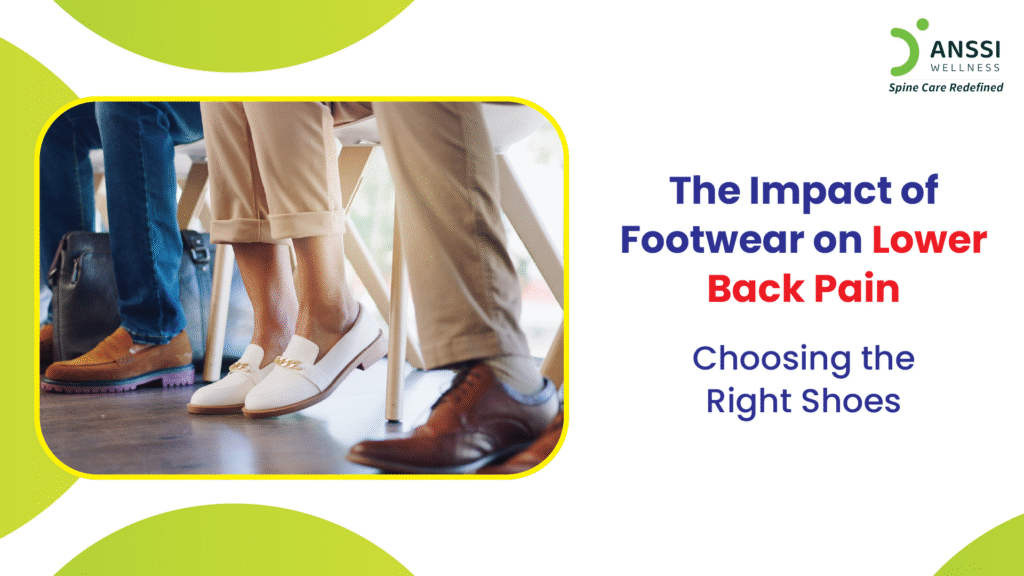Lower back pain is one of the most common health complaints among adults today. While many people blame poor posture, long working hours, or lack of exercise, very few realise that their footwear could be the hidden culprit behind their recurring back discomfort.
The shoes you wear play a vital role in maintaining your posture, balance, and spinal alignment. Choosing the wrong pair can unknowingly strain your back, leading to chronic pain and long-term damage.
How Footwear Affects Spinal Alignment
Every step you take begins at your feet, and the way your foot strikes the ground determines how forces travel up through your legs, hips, and spine. Proper footwear helps in absorbing shock, supporting your arches, and maintaining balanced alignment. When this support is missing, the spine compensates by adjusting posture unnaturally, leading to uneven pressure on the lower back.
High heels, for instance, push your body weight forward, forcing your lower spine to arch more than normal. On the other hand, completely flat shoes or flip-flops lack cushioning, allowing repeated impact on the spine with each step. Over time, these misalignments can contribute to muscle fatigue, disc compression, and chronic lower back pain.
Common Footwear Mistakes That Cause Back Pain
1. High Heels
While fashionable, high heels drastically alter your body’s center of gravity. They shift pressure from the heels to the front of your feet, increasing strain on your lower back and knees.
Wearing heels frequently can shorten your calf muscles, tighten your hamstrings, and increase the natural curve of your lower spine, all of which lead to discomfort and potential long-term damage.
2. Flat Shoes and Flip-Flops
Many people assume that flat footwear is safer for the back, but shoes without proper arch or heel support can be equally harmful.
Flat soles fail to absorb shock properly, causing jarring impact forces to travel directly up the spine. Over time, this can result in inflammation and stiffness in the lower back.
3. Worn-Out or Unsupportive Shoes
Old shoes with worn-out soles lose their ability to cushion and stabilise your movements. Uneven soles may also cause one side of your body to bear more weight than the other, disturbing spinal alignment and contributing to pain and fatigue.
Tips for Choosing Spine-Friendly Footwear
Finding the right shoes can make a significant difference in reducing lower back pain. Here are some practical tips to help you make spine-healthy choices:
- Look for Proper Arch Support: Choose footwear that supports the natural curve of your feet. Good arch support prevents overpronation (rolling inwards) or supination (rolling outwards), both of which can lead to spinal misalignment.
- Opt for Cushioning: Shoes with soft, shock-absorbing soles help reduce the impact on your spine during walking or standing.
- Moderate Heel Height is Best: Ideally, your heel should be about 1-2 inches higher than the front of your shoe. This small lift provides balance and reduces strain on the lower back.
- Ensure Correct Fit: Ill-fitting shoes, whether too tight or too loose, can throw off your posture and walking rhythm. Always try on shoes at the end of the day, when your feet are slightly swollen, for an accurate fit.
- Use Orthotic Insoles if Needed: Custom orthotic inserts can provide additional arch support, improve foot stability, and reduce pressure on your spine, especially if you have flat feet or plantar fasciitis.
Lifestyle Adjustments to Complement Foot Health
Good footwear alone cannot solve all back issues. Incorporating simple lifestyle changes can further enhance spine health:
- Stretch Regularly: Perform calf, hamstring, and lower back stretches daily to release tension and maintain flexibility.
- Maintain Good Posture: Whether standing or sitting, keep your shoulders relaxed and spine straight. Avoid slouching or leaning excessively on one side.
- Alternate Shoes: Avoid wearing the same pair of shoes every day. Rotating footwear gives your muscles and joints time to adjust.
- Walk Mindfully: Be conscious of how your feet land when you walk. Aim for smooth, even strides with your head held high and shoulders back.
When to Seek Professional Help
If you experience persistent lower back pain that does not improve with rest, posture correction, or better footwear, it’s time to consult a spine specialist. Continuous stress on the spine can lead to more serious conditions such as disc bulge, sciatica, or spinal compression.
Non-surgical treatments play a vital role in managing pain and improving spinal health.
- Physiotherapy strengthens core and back muscles, enhances flexibility, and restores proper movement patterns, reducing the risk of recurring pain.
- Ice therapy helps reduce inflammation and swelling after acute injuries, while heat therapy relaxes tight muscles and improves blood circulation for faster healing.
- Correcting posture further prevents unnecessary strain on the spine, neck, and shoulders, promoting better alignment and balance.
- Individuals suffering from chronic back pain can find lasting relief through Non-Surgical Spinal Decompression Treatment. This advanced treatment uses a targeted decompression mechanism to gently stretch the spine, relieve pressure on spinal discs, and restore natural alignment.
About ANSSI:
ANSSI Wellness focuses on improving the quality of life for patients suffering from spinal issues, aiming to provide relief where other conventional treatments have failed. Through advanced Non-Surgical Spinal Decompression Treatment, ANSSI is committed to helping patients avoid surgery and recover in a safe, effective, and compassionate environment.
Connect with ANSSI Wellness on LinkedIn, Instagram, and Facebook for expert guidance.




